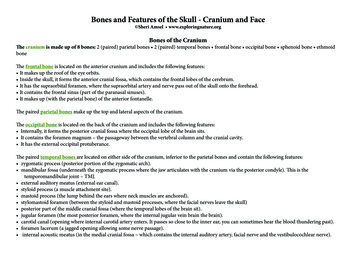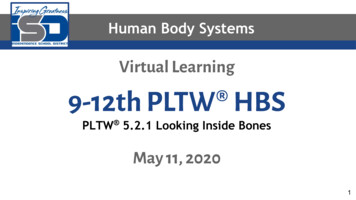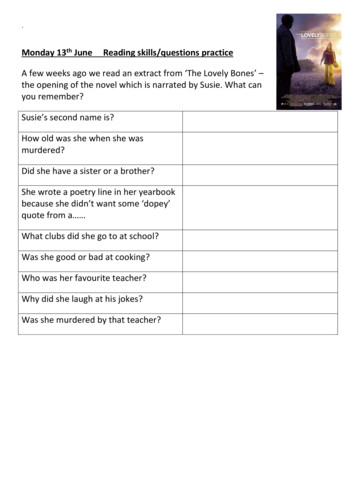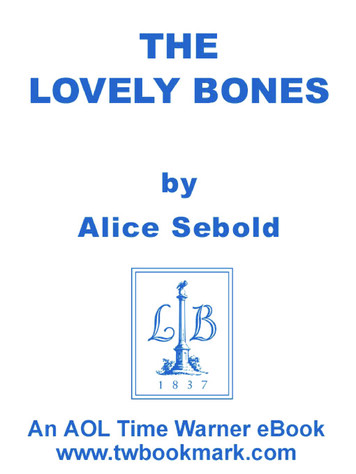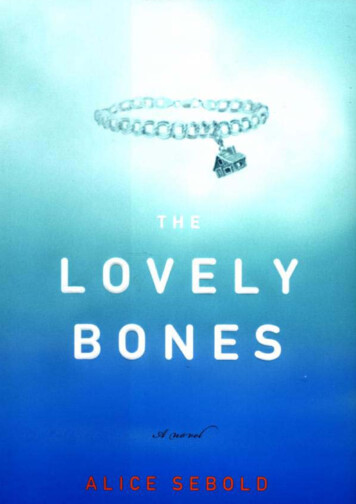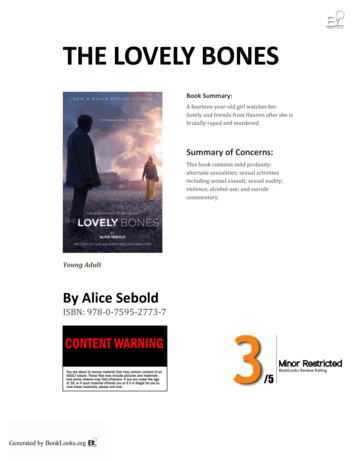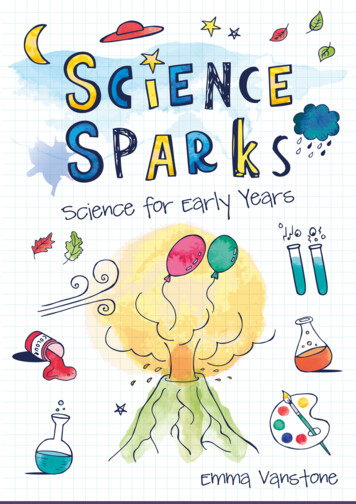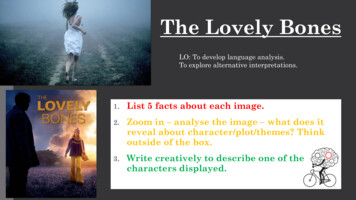
Transcription
The Lovely BonesLO: To develop language analysis.To explore alternative interpretations.1.List 5 facts about each image.2.Zoom in – analyse the image – what does itreveal about character/plot/themes? Thinkoutside of the box.3.Write creatively to describe one of thecharacters displayed.
Q1 – Identifying, synthesising andinterpreting Information (AO1/4) For homework, you should have read the text and answered the 10 ‘Q1Style” questions. Let’s mark them as a class.
Or answer a created Q2 from homework– skip to slide 12.8 Marks10 MinutesRead again lines 11 to 20. How does thewriter use language here to describe Mr.Botte? (8 marks) You must focus on the effect of thelanguage. What impact does it haveon the reader? Select quotations with precision –zoom in on the impact of specificwords. Pay attention to the section of theextract you have been asked to read.MethodEvidenceAnalysis1) Use your opening sentence to refer toa method the author has used.2) Select a quotation from the text –pick out a key quotation.3) Analyse the meanings andconnotations within the quotation – thisshould be the longest part of theparagraph.Emotive languageMetaphorPersonificationNoun(Dynamic) VerbSemantic fieldSimileAsyndetic listAdjectiveAdverb
How does the writer use language here todescribe Mr Botte? Expected Read the extract . Highlight and label any wordclasses or short phrases thatcontribute to the suspense. In another colour highlightand label any devices that thewriter uses. In a final colour highlight thesentence forms used to helpshowcase the suspense. Challenge1.For each word, device orsentence highlighted,annotate the connotationscreated.2.Cluster similar types ofwords, devices or sentencestogether and annotate whatyou think their overalleffects are.3.Does the intensity ofsuspense shift or develop?How does the language helpreflect this?
Quote explosion – push for alternative interpretations.“Mr Bottecame to mymemorialand criedquite a bit.”
What else did you pick?
:Method:Quote:Quote:Analysis:Analysis:
Question 2 – Language (three to four paragraphs)The writer uses the phrase to suggest . As readersthis creates the image of for us because . It also s suggestsThis highlightsThis connotesThis impliesThis portraysThis showsThis exemplifiesThis illustratesThis would affect thereader because This creates a senseof This is effectivebecause Gives the impressionof This makes the readerfeel
“Mr Botte came to my memorial and cried quite a bit.”Class model The writer uses the verb ‘cried’ to show the reader Mr Botte was visiblyupset. This evokes sympathy for him which is emphasised further throughthe phrase “quite a bit”, which implies Susie is a little surprised at the effectthe death has had on her teacher. This also portrays Mr Botte has beenpersonally affected, possibly because of his own daughter, and shows thereader a traumatic experience for the teacher.
Or answer a created Q2 from homework.8 Marks10 MinutesRead again lines 11 to 20. How does thewriter use language here to describe Mr.Botte? (8 marks) You must focus on the effect of thelanguage. What impact does it haveon the reader? Select quotations with precision –zoom in on the impact of specificwords. Pay attention to the section of theextract you have been asked to read.MethodEvidenceAnalysis1) Use your opening sentence to refer toa method the author has used.2) Select a quotation from the text –pick out a key quotation.3) Analyse the meanings andconnotations within the quotation – thisshould be the longest part of theparagraph.Emotive languageMetaphorPersonificationNoun(Dynamic) VerbSemantic fieldSimileAsyndetic listAdjectiveAdverb
/8Level 4Detailed,perceptiveanalysis7 – 8 marksLevel 3Clear, relevantexplanationLanguage Paper 1 –LanguageAnalysis of effect of language.Judicious range of textual references/quotes.Sophisticated and accurate use of subjectterminology.Clear explanations of effect of language.Range of textual references/quotes.Clear and accurate use of subject terminology.5 – 6 marksHave you madea range of clearpoints aboutthe languagetechniquesused?Have youincluded arange ofquotations?Have youexplained theeffect of thelanguagetechniques onthe reader?Have you triedto develop arange ofinterpretationsof thelanguage?Attempts to comment on the effect of language.Level 2Someunderstandingand comment3 – 4 marksLevel 1Simple, limitedcomment1 – 2 marksSelects some appropriate references/quotes.Some use of subject terminology, mainlyappropriately.Simple comment on the effect of language.Selects simple references/quotes.Simple use of subject terminology, not alwaysappropriately.
Now you know the text really well,what other possible LANGUAGEquestions could be asked of it?-Think about the mood/atmosphere createdConsider the way the characters/setting are presented/describedConsider the relationships between the charactersThink about the tension/movement2. How does the writer use language hereto ?You could include the writer’s choice of: Words and phrases Language techniques Sentence forms[8marks]
:Method:Quote:Quote:Analysis:Analysis:
Question 2 – Language (three to four paragraphs)The writer uses the phrase to suggest . As readersthis creates the image of for us because . It also s suggestsThis highlightsThis connotesThis impliesThis portraysThis showsThis exemplifiesThis illustratesThis would affect thereader because This creates a senseof This is effectivebecause Gives the impressionof This makes the readerfeel
8 Marks10 Minutes2. How does the writer use language hereto ?(8 marks) You must focus on the effect of thelanguage. What impact does it haveon the reader? Select quotations with precision –zoom in on the impact of specificwords. Pay attention to the section of theextract you have been asked to read.MethodEvidenceAnalysis1) Use your opening sentence to refer toa method the author has used.2) Select a quotation from the text –pick out a key quotation.3) Analyse the meanings andconnotations within the quotation – thisshould be the longest part of theparagraph.Emotive languageMetaphorPersonificationNoun(Dynamic) VerbSemantic fieldSimileAsyndetic listAdjectiveAdverb
/8Level 4Detailed,perceptiveanalysis7 – 8 marksLevel 3Clear, relevantexplanationLanguage Paper 1 –LanguageAnalysis of effect of language.Judicious range of textual references/quotes.Sophisticated and accurate use of subjectterminology.Clear explanations of effect of language.Range of textual references/quotes.Clear and accurate use of subject terminology.5 – 6 marksHave you madea range of clearpoints aboutthe languagetechniquesused?Have youincluded arange ofquotations?Have youexplained theeffect of thelanguagetechniques onthe reader?Have you triedto develop arange ofinterpretationsof thelanguage?Attempts to comment on the effect of language.Level 2Someunderstandingand comment3 – 4 marksLevel 1Simple, limitedcomment1 – 2 marksSelects some appropriate references/quotes.Some use of subject terminology, mainlyappropriately.Simple comment on the effect of language.Selects simple references/quotes.Simple use of subject terminology, not alwaysappropriately.
The Lovely BonesLO: To revise and practise the approach to Q3Apostrophe or not? Make the corrections, if needed.Russell’s play is a criticism of how the working classes were treated.Mickeys life choices are limited and theyre as a result of his upbringing.Mrs Lyon’s parenting is better than Mrs Johnstones.Correct the spelling ilaudianceArgue for/against one of thestatements above.
Remind me of what we need toremember: Step 1: Work out what ishappening.(WriteYou now need to thinkabout the wholesource. in margin) How has the writer structured the text to interest you as a reader? You could write about: What the writer focuses your attention on at the beginning of the source How and why the writer changes this focus as the source develops Any other structural features that interest you. [8 marks] Q3:Step 2: Effect – why has the writermade these choices?Step 3: Terminology
Structure Listen Markto me read the article to you again.down where and when the shifts infocus/perspective occur.
StructureRemember to consider: How structure is used Why it is used The effects on thereader! Listen to me read the article to you again. Mark down where and when the shifts in focus/perspective occur. Discuss, in groups, and annotate: The focus at the beginning – setting? Mood? Perspective?How this changes and/or developsHow does the text end – why?What is the narrative perspective?Are there any other structural techniques being used? Use the prompt ifneeded.
StructureStep 1: what is happening. Write inmargin1.2.3.4.5.6.7.8.9.10.
StructureStep 2: effect – why has the writer made these choices?Choose 4 to explain.1.2.3.4.
Step 3 - Structure Terminology at first then at this point narrows down now focusesthe author thenintroducesthe author goes back Conclusionto Chronological changes the scene to Climactic moment shifts away from Flashbacks/Flashforw Locationard Setting Foreshadow Protagonist Repetition 1st/2nd/3rd personnarration Repeated motif Unreliable/omniscientnarrator Introductionfinally wide view eventually
Structure – Feedback for Class Plan
StructureThe opening sentence of the novel immediately arouses the curiosity of the reader as the narratorspeaks about herself in the past tense, which is most unusual, when she says: "My name wasSalmon" followed immediately by the statement: "I was murdered on December 6, 1973." This iscompletely unexpected and effectively surprises the reader, who is now curious to know more.The narrative focus then shifts to a quotation in a yearbook and then widens as the narratordescribes her favourite teacher, Mr. Botte. However, just when the reader is beginning to thinkMr. Botte might be her murderer, she states: "I wasn't killed by Mr. Botte, by the way." Thenarrative focus then narrows on Mr. Botte and his own daughter who also died as a child.What follows is a focus on the narrator's murderer. The fact that he was "a man from ourneighborhood" whom both her mother and father knew adds more interest for readers of this storybecause we now wonder whether they know this man is their daughter's murderer and we arecurious to learn whether or not he will be caught.The focus then shifts again to the night and the location of the narrator's murder, signalled by thesame date mentioned in the opening paragraph. The dialogue between Susie and Mr. Harvey ismainly spoken in telegraphic sentences, suggesting to the reader that their conversation is stiltedand awkward or uncomfortable. The telegraphic sentences create tension and suspense as thereaders wonder if he might be her murderer.
StructureThe opening sentence of the novel immediately arouses the curiosity of the reader as the narratorspeaks about herself in the past tense, which is most unusual, when she says: "My name wasSalmon" followed immediately by the statement: "I was murdered on December 6, 1973." This iscompletely unexpected and effectively surprises the reader, who is now curious to know more.The narrative focus then shifts to a quotation in a yearbook and then widens as the narratordescribes her favourite teacher, Mr. Botte. However, just when the reader is beginning to think Mr.Botte might be her murderer, she states: "I wasn't killed by Mr. Botte, by the way." The narrativefocus then narrows on Mr. Botte and his own daughter who also died as a child.What follows is a focus on the narrator's murderer. The fact that he was "a man from ourneighborhood" whom both her mother and father knew adds more interest for readers of this storybecause we now wonder whether they know this man is their daughter's murderer and we are curiousto learn whether or not he will be caught.The focus then shifts again to the night and the location of the narrator's murder, signalled by thesame date mentioned in the opening paragraph. The dialogue between Susie and Mr. Harvey ismainly spoken in telegraphic sentences, suggesting to the reader that their conversation is stiltedand awkward or uncomfortable. The telegraphic sentences create tension and suspense as thereaders wonder if he might be her murderer.
Your turn: Q3: You now need to think about the wholesource. How has the writer structured the textto interest you as a reader? You could write about: What the writer focuses your attentionon at the beginning of the source How and why the writer changes thisfocus as the source develops Any other structural features thatinterest you. [8 marks] The narrative begins with . . . andthe author describes . . . The focus then shifts to . . . and thepurpose of the dialogue . . The author begins to develop tensionwhen . . . The tension is heightened by the use ofdialogue which is . . . The narrative reaches its climax withan interesting structural device . .
Question 3 – Structure (three to four paragraphs)At the start of the extract, the writer focuses our attention on to suggest . I thinkthis is effective because .In the middle of the extract the writer uses to suggest . I think this is effectivebecause .Towards the end of the extract the writer uses to suggest . I think this is effectivebecause .BeginningMiddleEndShift in focusNarrative perspectiveFlashback / oxForeshadowingLinear narrative / nonLinear gShowingThis exemplifiesThis illustratesThis would affect the readerbecause This creates a sense of This is effective because Gives the impression of This makes the reader feel
It is not ok to justidentify differentstructural features you must analyse whateffect these have onthe reader.Why does thebigger picturematter?This is what theexaminer islooking for!You will need to analyse aminimum of 4 quotations tobe able to hit this level.Ideally you want to include 46 quotations.You must use subjectterminology, otherwiseyou cannot get above2marks.Peer Assessment
The Lovely Bones1.Dirty 30 BIGLO: To revise and practise the approach to Q4
Question 4 Evaluation1) Agree with thestatement2) First reason foragreeing3) Quotation(integrated) to provethat you agree4) Effect andevaluation oflanguage (PECS)5) Agree withstatement once moreALWAYS AGREEIt is much easier tofind things thatSUPPORT thestatement.20 marks25 minutesWhat is the 5 point structureyou’ve been taught for thisquestion?CONSTANTREFERENCE TOQUESTIONUse the words fromthe questionconstantlyIntegrate PECS atevery availableopportunity to showyou areEVALUATINGlanguagePECS
HATQ4: Focus this part of your answer from line 21 to the end of the extract. Astudent, having read this part of the text said: “In this part of the text, Susieacts naively and makes mistakes.”To what extent do you agree?In your response, you should: Write about the ways she acts naively Evaluate how the writer shows this Support your opinions with quotations from the text[20 marks]
How might we re-word the question inour writing?“Susie is naive and makes mistakes ” innocent doesn’t think things through makes poor choices is too trusting behaves like a child
MAT/LATQ4: Focus this part of your answer from line 21 to the end of the extract. Astudent, having read this part of the text said: “This part of the text is verytense; the reader is waiting for something bad to happen.”To what extent do you agree?In your response, you should: Write about the way that the writer increases the tension Evaluate how the writer makes this a dramatic moment Support your opinions with quotations from the text[20 marks]
How might we re-word the question inour writing?“This moment is tense ” dramatic eerie intense suspenseful The reader is expecting something bad on edge scared
Q4ApproachRead again the lines referred to inthe extractAnnotate quotations – ensure allquotes selected link to theSTATEMENTLocate METHODS – HOW has thewriter created these impressions(use of specific lexis orwriting/structural techniques?)Ensure methods and effectslocated SUPPORT the statementfor your AGREE point of view(PECS to evaluate!)
NaiveOn the following slides are 3 quotations I haveselected – please explode them with PECS andEFFECT in response to the Q4.‘I took ashortcut itwas dark out’Makes mistakes
NaiveOn the following slides are 3 quotations I haveselected – please explode them with PECS andEFFECT in response to the Q4.‘I wish nowthat I hadknown this wasweird. I hadnever told himmy name.Makes mistakes
TenseOn the following slides are 3 quotations I haveselected – please explode them with PECS andEFFECT in response to the Q4.‘I took ashortcut itwas dark out’Waiting forsomething bad
TenseOn the following slides are 3 quotations I haveselected – please explode them with PECS andEFFECT in response to the Q4.‘I wish nowthat I hadknown this wasweird. I hadnever told himmy name.Waiting forsomething bad
Live model1) Agree with thestatement2) First reason foragreeing3) Quotation(integrated) to provethat you agree4) Effect andevaluation of language(PECS)5) Agree withstatement once moreYour turn
Question 4 – Evaluate (four to six paragraphs)1) Agree with the statement2) First reason for agreeing3) Quotation (integrated) to prove that you agree4) Effect and evaluation of language (PECS)5) Agree with statement once bNounHyperbole
Mark schemeCan you green pen a brief EBI?Self assessment is key!
Create your own Q4 and plan aresponse Consider: Characters Emotions Reader’s reactions Mood/atmosphere
LO: To revise and practise creative writing skills.The Lovely Bones1.Dirty 30 BIG
5. Your school or college isasking students to contributesome creative writing for itswebsite.Either: Write a narrative suggestedby the pictureOr: Describe an occasion when youfelt worried about something. Focuson the thoughts and feelings you hadat the time.
DESCRIPTIVENARRATIVEWhat are the‘ingredients’?
Discussion around ideasDon’t just describe thepicture – what does itprompt? Characters Their lives Their emotions Their history Flashbacks Setting Emotions
Create a semantic map.Think outside the box!
Adjectives NounsVerbsAdverbsI sprinted towards safety. Add a PHRASE at the beginning of thesentence. Add an ADJECTIVE before the NOUN
Planning your responseE.GPARAGRAPH 1PANORAMICPARAGRAPH 5ZOOM INPARAGRAPH 2ZOOM INPARAGRAPH 6 – One LinePARAGRAPH 7ZOOM INPARAGRAPH 3 – One linePARAGRAPH 4ZOOM INPARAGRAPH 8PANORAMIC WITH A CHANGE
Openings
Use directspeechStart withsomethingvery oddStart in themiddle ofsomethingStoryBeginningsCreate avery clearpictureCreate atenseatmosphereMake yourreaderlaughTalk to yourreader: usefirst personnarrativeShock yourreader
Endings
Lesson ryEndingsDialogueendingMake -hanger
Independent Writing5. Your school orcollege is askingstudents tocontribute somecreative writingfor its website.Either: Write anarrative suggestedby the pictureOr: Describe anoccasion when youfelt worried aboutsomething. Focus onthe thoughts andfeelings you had atthe time. Detailed descriptions –saying a lot about a little Higher level vocabulary Language techniques anddevices Accurate use of basicpunctuation Higher level punctuation Variety of sentencelengths and structures Paragraphs – accurateand unusual
Have a go at using the skilldescriptors for AO5 AND AO6 todetermine which band yourparagraph sits in so far
Green pen for growthLabel your response with all of the awesome things you didwithin your writing.-Where did you meet the Secret 7?-Where did you WOW with your vocab?-Where did you use dashes and semicolons?-Create a WWW and an EBI based on the mark scheme and yourlabelled positives -What might you’ve missed?-What could you have done better next time?-Where could there have been a semicolon?
The Lovely Bones 1. List 5 facts about each image. 2. Zoom in - analyse the image - what does it reveal about character/plot/themes? Think outside of the box. 3. Write creatively to describe one of the characters displayed. LO: To develop language analysis. To explore alternative interpretations.



